ecm terminal SUZUKI SX4 2006 1.G Service Manual Online
[x] Cancel search | Manufacturer: SUZUKI, Model Year: 2006, Model line: SX4, Model: SUZUKI SX4 2006 1.GPages: 1556, PDF Size: 37.31 MB
Page 215 of 1556

Downloaded from www.Manualslib.com manuals search engine Engine General Information and Diagnosis: 1A-165
DTC P2227 / P2228 / P2229: Barometric Pressure Circuit MalfunctionS6RW0D1104068
DTC P2227: Barometric Pressure Circuit Range / Performance
DTC P2228: Barometric Pressure Circuit Low
DTC P2229: Barometric Pressure Circuit High
System Description
Barometric pressure sensor is installed in ECM.
DTC Detecting Condition and Trouble Area6Wire harness check
1) Disconnect connectors from ECM with ignition switch
turned OFF.
2) Check for proper connection of ECM connector at “E01-
37”, “E01-52”, “E01-36” and “E01-51” terminals.
3) If OK, measure resistance between “GRN” wire terminal
of APP sensor assembly connector and vehicle body
ground, between “YEL” wire terminal of APP sensor
assembly connector and vehicle body ground.
Is each resistance infinity?Go to Step 7. “GRN” wire or “YEL”
wire is shorted to other
circuit.
7Wire harness check
1) Turn ON ignition switch.
2) Measure voltage between “E01-37” terminal of ECM
connector and engine ground, between “E01-36”
terminal of ECM connector and engine ground.
Is each voltage 0 V?Go to Step 8. “GRN” wire or “YEL”
wire is shorted to other
circuit.
8APP sensor assembly check
1) 1)Check APP sensor referring to “Accelerator Pedal
Position (APP) Sensor Assembly Inspection in Section
1C”.
Is output voltage within specified value?Substitute a known-
good ECM and recheck.Replace APP sensor
assembly. Step Action Yes No
DTC detecting condition Trouble area
DTC P2227:
Difference of barometric pressure value and intake manifold pressure value
is more than specified value while engine cranking.
(2 driving cycle detection logic)• Manifold absolute pressure sensor
performance problem
• Barometric pressure sensor in ECM
DTC P2228:
Barometric pressure signal is lower than specified value.
(1 driving cycle detection logic)• Barometric pressure sensor in ECM
DTC P2229:
Barometric pressure signal is higher than specified value.
(1 driving cycle detection logic)
Page 218 of 1556

Downloaded from www.Manualslib.com manuals search engine 1A-168 Engine General Information and Diagnosis:
Troubleshooting
Step Action Yes No
1DTC Check
1) Turn ignition switch to OFF position.
2) Connect scan tool to DLC.
3) Check DTC in the following control modules.
•ECM
•TCM
•BCM
• Keyless start control module
• 4WD control module
Is there any DTC other than CAN-DTC?Go to applicable
troubleshooting of DTC
other than CAN-DTC.Go to Step 2.
2Control module connector check
1) Turn ignition switch to OFF position.
2) Be sure to disconnect scan tool from DLC.
3) Disconnect all the following control module connectors.
• Control modules communicated by CAN
–ECM
–TCM
– ABS control module
–BCM
– Combination meter
– Keyless start control module
– 4WD control module
4) Check for proper connection to terminal of each CAN
line of all control module (communicated by CAN)
connectors.
5) If OK, connect all connectors of control module
communicated by CAN securely.
6) Recheck DTC for all control modules communicated by
CAN.
Is there any CAN-DTC?Go to Step 3. Intermittent trouble.
Check for intermittent
referring to “Intermittent
and Poor Connection
Inspection in Section
00”.
Page 220 of 1556

Downloaded from www.Manualslib.com manuals search engine 1A-170 Engine General Information and Diagnosis:
6Terminating resistance check in ECM and combination
meter
1) Turn ignition switch to OFF position and then disconnect
negative (–) cable at battery.
2) Measure resistance between CAN High terminal (2) and
CAN Low terminal (3) on DLC (1).
If resistance 57 – 67
Ω?Go to Step 7. Go to Step 8.
7Substitute ECM and recheck
1) Substitute a known-good ECM and recheck.
Is it in good condition?End. Substitute a known-
good combination meter
and recheck. If NG, go
to Step 11.
8Terminating resistance check in ECM
1) Make sure that ignition switch is OFF position and
battery negative (–) cable is disconnected.
2) Disconnect combination meter connector.
3) Measure resistance between CAN high terminal and
CAN low terminal on DLC as the same manner as Step
6.
Is resistance 114 – 134
Ω?Substitute a known-
good combination
meter.Go to Step 9.
9Internal circuit check in BCM
1) Make sure that ignition switch is OFF position and
battery negative (–) cable is disconnected.
2) Disconnect ABS control module connector.
3) Measure resistance between the followings
• Between CAN high terminal on DLC and “E08-2”
terminal on ABS control module connector
• Between CAN low terminal on DLC and “E08-13”
terminal on ABS control module connector
Is each resistance 0 – 1
Ω?Go to Step 10. Substitute a known-
good BCM.
10Internal circuit check in ABS control module
1) Make sure that ignition switch is OFF position and
battery negative (–) cable is disconnected.
2) Connect ABS control module connector and disconnect
ECM connector.
3) Measure resistance between the followings
• Between CAN High terminal on DLC and “E01-3”
terminal on ECM connector
• Between CAN Low terminal on DLC and “E01-18”
terminal on ECM connector
If each resistance 0 – 1
Ω?Substitute a known-
good ECM and recheck.
If NG, go to step 11.Substitute a known-
good ABS control
module.
11Substitute BCM and recheck
1) Substitute a known-good BCM and recheck.
Is it in good condition?End. Substitute a known-
good ABS control
module. Step Action Yes No
2
1
9 10 11 12 13 14 15 16
1 2 3 4 5 6 7 8
3
I7RW01110098-01
Page 222 of 1556

Downloaded from www.Manualslib.com manuals search engine 1A-172 Engine General Information and Diagnosis:
Inspection of ECM and Its CircuitsS6RW0D1104072
ECM and its circuits can be checked by measuring voltage, pulse signal and resistance with special tool connected.
CAUTION!
ECM cannot be checked by itself. It is strictly prohibited to connect voltmeter or ohmmeter to ECM
with ECM connectors disconnected from it.
Voltage Check
1) Remove ECM (1) from its bracket referring to “Engine Control Module (ECM) Removal and Installation in Section
1C”.
2) Connect special tool between ECM and ECM connectors securely.
Special tool
(A): 09933–06320
3) Check voltage and/or pulse signal using voltmeter (2) and oscilloscope (3).
NOTE
• As each terminal voltage is affected by battery voltage, confirm that it is 11 V or more when ignition
switch is turned ON.
• Voltage with asterisk (*) cannot be measured with voltmeter because it is pulse signal. Use
oscilloscope for its check if necessary.
• Before this inspection, be sure to read the “Precautions of ECM Circuit Inspection”.
Viewed from harness side
1
2
3(A)
I5JB0A110073-01
E01C01
3 4
18 19 5 6 7 10 11
17 20
47 46 49 50 51 21 22
5216 259
24 14
29
55 57 54 53 59
60 582
26 27 28 15
30
56 4832 31 34 35 36 37 40 42 39 38 44
45 43 41 331 12 13
238 3 4
18 19 5 6 7 10 11
17 20
47 46 49 50 51 21 22
5216 259
24 14
29
55 57 54 53 59
60 582
26 27 28 15
30
56 4832 31 34 35 36 37 40 42 39 38 44
45 43 41 331 12 13
238
I6RW0D110051-01
Page 224 of 1556
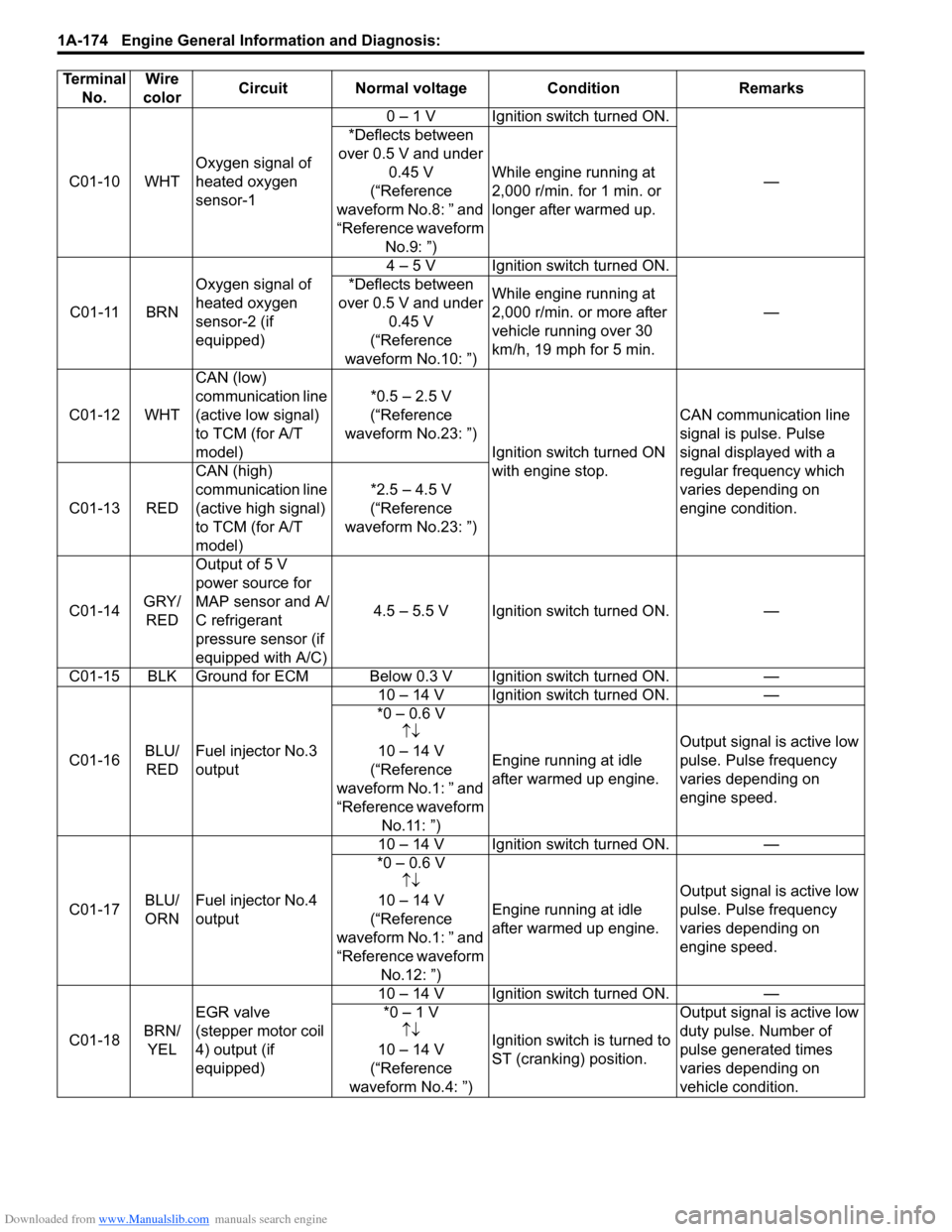
Downloaded from www.Manualslib.com manuals search engine 1A-174 Engine General Information and Diagnosis:
C01-10 WHTOxygen signal of
heated oxygen
sensor-10 – 1 V Ignition switch turned ON.
— *Deflects between
over 0.5 V and under
0.45 V
(“Reference
waveform No.8: ” and
“Reference waveform
No.9: ”)While engine running at
2,000 r/min. for 1 min. or
longer after warmed up.
C01-11 BRNOxygen signal of
heated oxygen
sensor-2 (if
equipped)4 – 5 V Ignition switch turned ON.
— *Deflects between
over 0.5 V and under
0.45 V
(“Reference
waveform No.10: ”)While engine running at
2,000 r/min. or more after
vehicle running over 30
km/h, 19 mph for 5 min.
C01-12 WHTCAN (low)
communication line
(active low signal)
to TCM (for A/T
model)*0.5 – 2.5 V
(“Reference
waveform No.23: ”)
Ignition switch turned ON
with engine stop.CAN communication line
signal is pulse. Pulse
signal displayed with a
regular frequency which
varies depending on
engine condition. C01-13 REDCAN (high)
communication line
(active high signal)
to TCM (for A/T
model)*2.5 – 4.5 V
(“Reference
waveform No.23: ”)
C01-14GRY/
REDOutput of 5 V
power source for
MAP sensor and A/
C refrigerant
pressure sensor (if
equipped with A/C)4.5 – 5.5 V Ignition switch turned ON. —
C01-15 BLK Ground for ECM Below 0.3 V Ignition switch turned ON. —
C01-16BLU/
REDFuel injector No.3
output10 – 14 V Ignition switch turned ON. —
*0 – 0.6 V
↑↓
10 – 14 V
(“Reference
waveform No.1: ” and
“Reference waveform
No.11: ”)Engine running at idle
after warmed up engine.Output signal is active low
pulse. Pulse frequency
varies depending on
engine speed.
C01-17BLU/
ORNFuel injector No.4
output10 – 14 V Ignition switch turned ON. —
*0 – 0.6 V
↑↓
10 – 14 V
(“Reference
waveform No.1: ” and
“Reference waveform
No.12: ”)Engine running at idle
after warmed up engine.Output signal is active low
pulse. Pulse frequency
varies depending on
engine speed.
C01-18BRN/
YELEGR valve
(stepper motor coil
4) output (if
equipped)10 – 14 V Ignition switch turned ON. —
*0 – 1 V
↑↓
10 – 14 V
(“Reference
waveform No.4: ”)Ignition switch is turned to
ST (cranking) position.Output signal is active low
duty pulse. Number of
pulse generated times
varies depending on
vehicle condition. Terminal
No.Wire
colorCircuit Normal voltage Condition Remarks
Page 225 of 1556
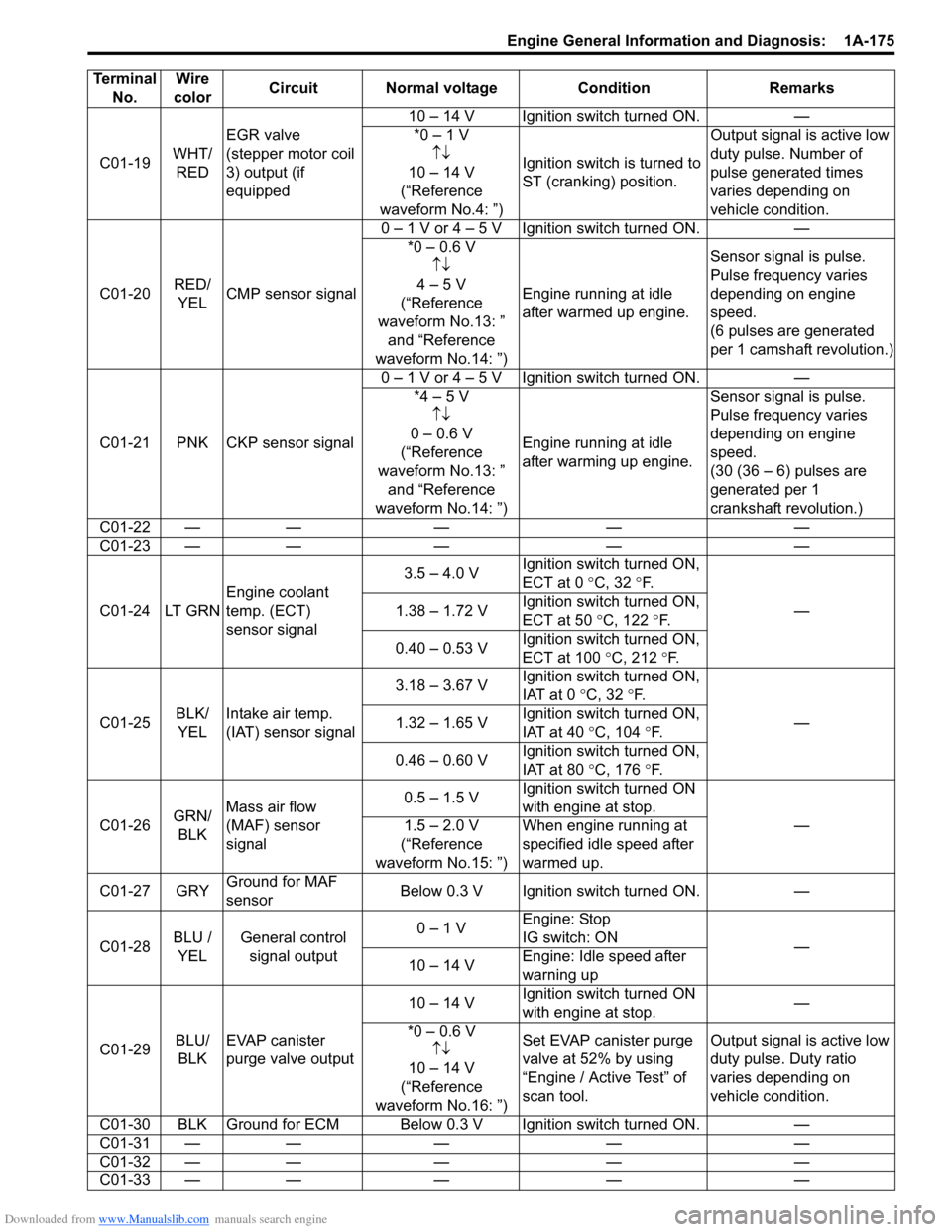
Downloaded from www.Manualslib.com manuals search engine Engine General Information and Diagnosis: 1A-175
C01-19WHT/
REDEGR valve
(stepper motor coil
3) output (if
equipped10 – 14 V Ignition switch turned ON. —
*0 – 1 V
↑↓
10 – 14 V
(“Reference
waveform No.4: ”)Ignition switch is turned to
ST (cranking) position.Output signal is active low
duty pulse. Number of
pulse generated times
varies depending on
vehicle condition.
C01-20RED/
YELCMP sensor signal0 – 1 V or 4 – 5 V Ignition switch turned ON. —
*0 – 0.6 V
↑↓
4 – 5 V
(“Reference
waveform No.13: ”
and “Reference
waveform No.14: ”)Engine running at idle
after warmed up engine.Sensor signal is pulse.
Pulse frequency varies
depending on engine
speed.
(6 pulses are generated
per 1 camshaft revolution.)
C01-21 PNK CKP sensor signal0 – 1 V or 4 – 5 V Ignition switch turned ON. —
*4 – 5 V
↑↓
0 – 0.6 V
(“Reference
waveform No.13: ”
and “Reference
waveform No.14: ”)Engine running at idle
after warming up engine.Sensor signal is pulse.
Pulse frequency varies
depending on engine
speed.
(30 (36 – 6) pulses are
generated per 1
crankshaft revolution.)
C01-22 — — — — —
C01-23 — — — — —
C01-24 LT GRNEngine coolant
temp. (ECT)
sensor signal3.5 – 4.0 VIgnition switch turned ON,
ECT at 0 °C, 32 °F.
— 1.38 – 1.72 VIgnition switch turned ON,
ECT at 50 °C, 122 °F.
0.40 – 0.53 VIgnition switch turned ON,
ECT at 100 °C, 212 °F.
C01-25BLK/
YELIntake air temp.
(IAT) sensor signal3.18 – 3.67 VIgnition switch turned ON,
IAT at 0 °C, 32 °F.
— 1.32 – 1.65 VIgnition switch turned ON,
IAT at 40 °C, 104 °F.
0.46 – 0.60 VIgnition switch turned ON,
IAT at 80 °C, 176 °F.
C01-26GRN/
BLKMass air flow
(MAF) sensor
signal0.5 – 1.5 VIgnition switch turned ON
with engine at stop.
— 1.5 – 2.0 V
(“Reference
waveform No.15: ”)When engine running at
specified idle speed after
warmed up.
C01-27 GRYGround for MAF
sensorBelow 0.3 V Ignition switch turned ON. —
C01-28BLU /
YELGeneral control
signal output0 – 1 VEngine: Stop
IG switch: ON
—
10 – 14 VEngine: Idle speed after
warning up
C01-29BLU/
BLKEVAP canister
purge valve output10 – 14 VIgnition switch turned ON
with engine at stop.—
*0 – 0.6 V
↑↓
10 – 14 V
(“Reference
waveform No.16: ”)Set EVAP canister purge
valve at 52% by using
“Engine / Active Test” of
scan tool.Output signal is active low
duty pulse. Duty ratio
varies depending on
vehicle condition.
C01-30 BLK Ground for ECM Below 0.3 V Ignition switch turned ON. —
C01-31 — — — — —
C01-32 — — — — —
C01-33 — — — — — Terminal
No.Wire
colorCircuit Normal voltage Condition Remarks
Page 227 of 1556
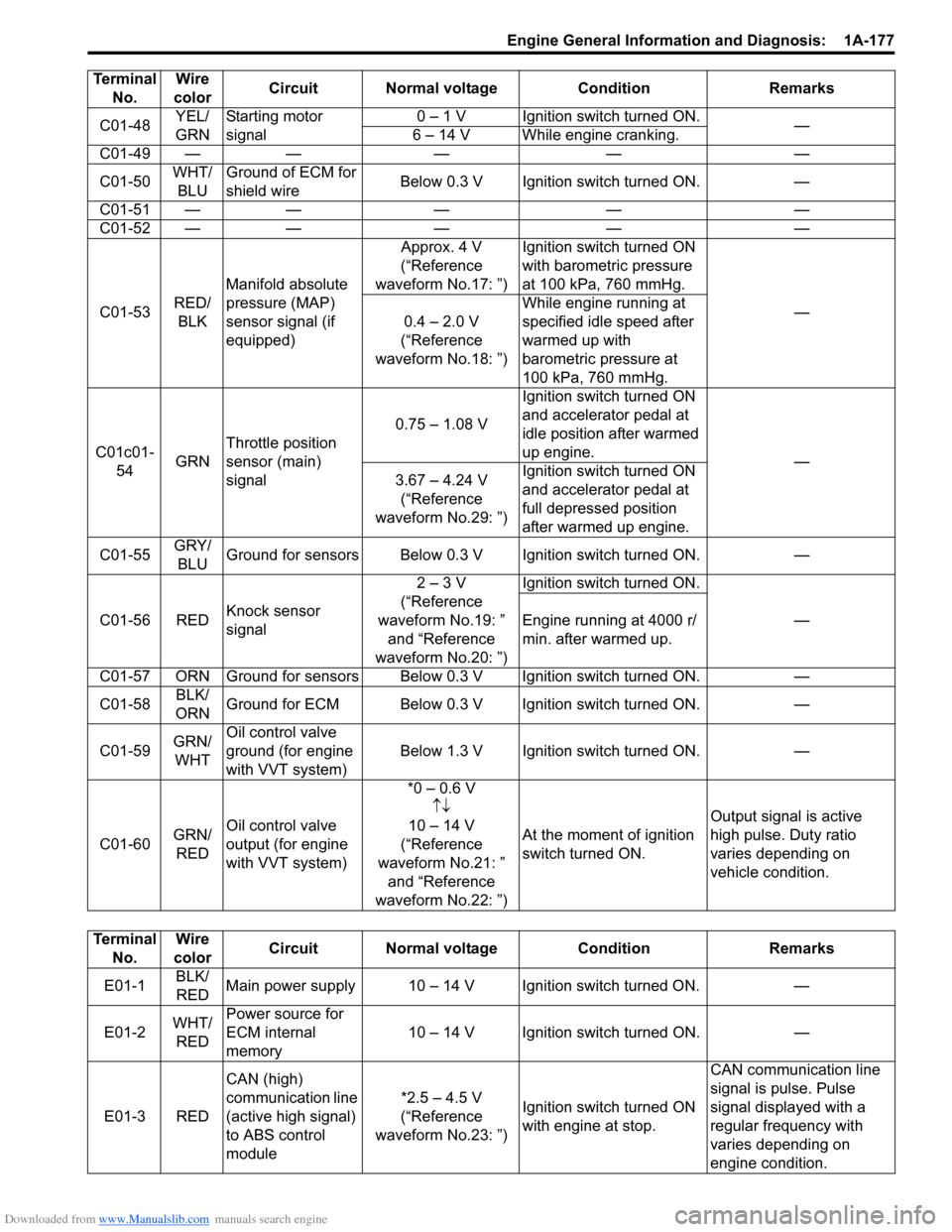
Downloaded from www.Manualslib.com manuals search engine Engine General Information and Diagnosis: 1A-177
C01-48YEL/
GRNStarting motor
signal0 – 1 V Ignition switch turned ON.
—
6 – 14 V While engine cranking.
C01-49 — — — — —
C01-50WHT/
BLUGround of ECM for
shield wireBelow 0.3 V Ignition switch turned ON. —
C01-51 — — — — —
C01-52 — — — — —
C01-53RED/
BLKManifold absolute
pressure (MAP)
sensor signal (if
equipped)Approx. 4 V
(“Reference
waveform No.17: ”)Ignition switch turned ON
with barometric pressure
at 100 kPa, 760 mmHg.
—
0.4 – 2.0 V
(“Reference
waveform No.18: ”)While engine running at
specified idle speed after
warmed up with
barometric pressure at
100 kPa, 760 mmHg.
C01c01-
54GRNThrottle position
sensor (main)
signal0.75 – 1.08 VIgnition switch turned ON
and accelerator pedal at
idle position after warmed
up engine.
—
3.67 – 4.24 V
(“Reference
waveform No.29: ”)Ignition switch turned ON
and accelerator pedal at
full depressed position
after warmed up engine.
C01-55GRY/
BLUGround for sensors Below 0.3 V Ignition switch turned ON. —
C01-56 REDKnock sensor
signal2 – 3 V
(“Reference
waveform No.19: ”
and “Reference
waveform No.20: ”)Ignition switch turned ON.
— Engine running at 4000 r/
min. after warmed up.
C01-57 ORN Ground for sensors Below 0.3 V Ignition switch turned ON. —
C01-58BLK/
ORNGround for ECM Below 0.3 V Ignition switch turned ON. —
C01-59GRN/
WHTOil control valve
ground (for engine
with VVT system)Below 1.3 V Ignition switch turned ON. —
C01-60GRN/
REDOil control valve
output (for engine
with VVT system)*0 – 0.6 V
↑↓
10 – 14 V
(“Reference
waveform No.21: ”
and “Reference
waveform No.22: ”)At the moment of ignition
switch turned ON.Output signal is active
high pulse. Duty ratio
varies depending on
vehicle condition. Terminal
No.Wire
colorCircuit Normal voltage Condition Remarks
Terminal
No.Wire
colorCircuit Normal voltage Condition Remarks
E01-1BLK/
REDMain power supply 10 – 14 V Ignition switch turned ON. —
E01-2WHT/
REDPower source for
ECM internal
memory10 – 14 V Ignition switch turned ON. —
E01-3 REDCAN (high)
communication line
(active high signal)
to ABS control
module*2.5 – 4.5 V
(“Reference
waveform No.23: ”)Ignition switch turned ON
with engine at stop.CAN communication line
signal is pulse. Pulse
signal displayed with a
regular frequency with
varies depending on
engine condition.
Page 229 of 1556
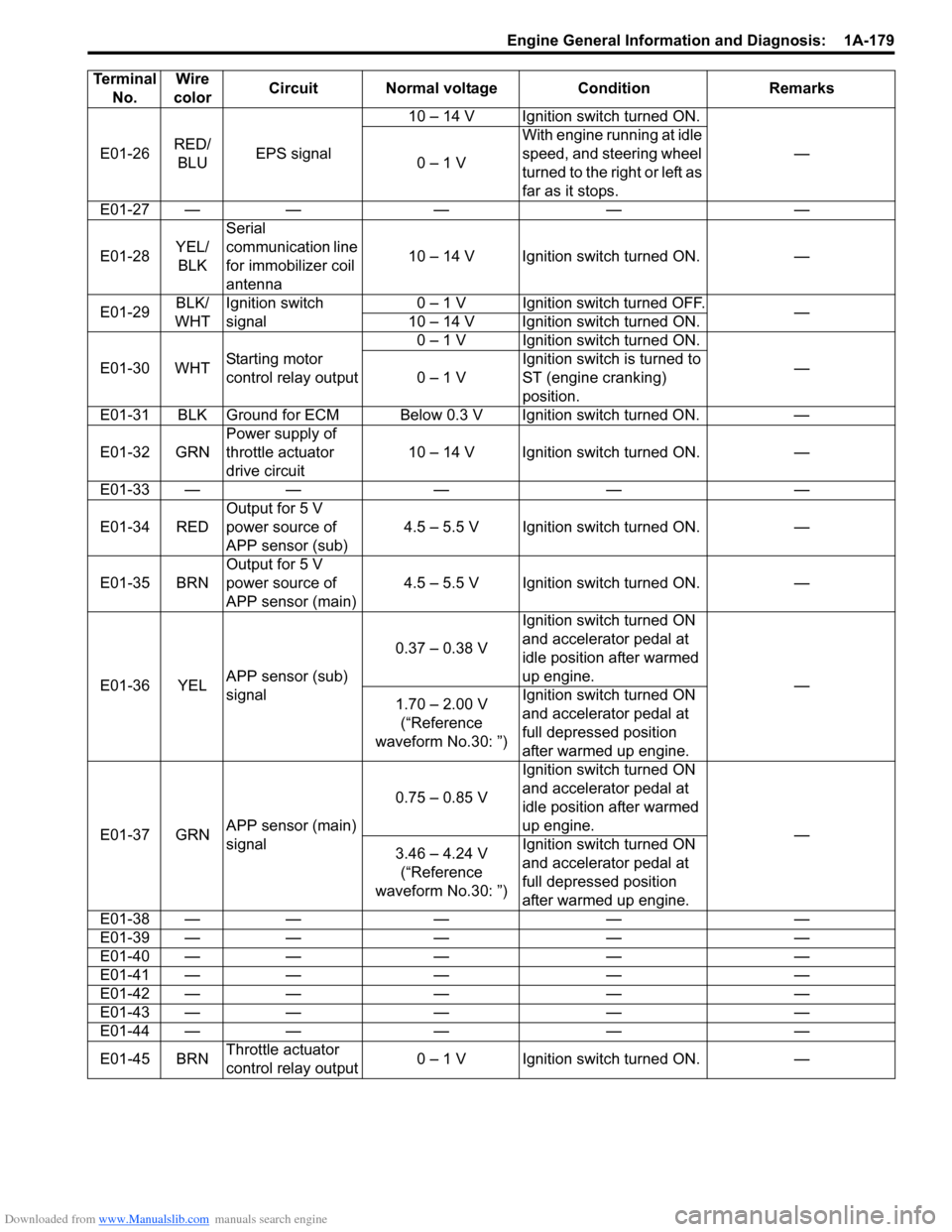
Downloaded from www.Manualslib.com manuals search engine Engine General Information and Diagnosis: 1A-179
E01-26RED/
BLUEPS signal10 – 14 V Ignition switch turned ON.
—
0 – 1 VWith engine running at idle
speed, and steering wheel
turned to the right or left as
far as it stops.
E01-27 — — — — —
E01-28YEL/
BLKSerial
communication line
for immobilizer coil
antenna10 – 14 V Ignition switch turned ON. —
E01-29BLK/
WHTIgnition switch
signal0 – 1 V Ignition switch turned OFF.
—
10 – 14 V Ignition switch turned ON.
E01-30 WHTStarting motor
control relay output0 – 1 V Ignition switch turned ON.
—
0 – 1 VIgnition switch is turned to
ST (engine cranking)
position.
E01-31 BLK Ground for ECM Below 0.3 V Ignition switch turned ON. —
E01-32 GRNPower supply of
throttle actuator
drive circuit10 – 14 V Ignition switch turned ON. —
E01-33 — — — — —
E01-34 REDOutput for 5 V
power source of
APP sensor (sub)4.5 – 5.5 V Ignition switch turned ON. —
E01-35 BRNOutput for 5 V
power source of
APP sensor (main)4.5 – 5.5 V Ignition switch turned ON. —
E01-36 YELAPP sensor (sub)
signal0.37 – 0.38 VIgnition switch turned ON
and accelerator pedal at
idle position after warmed
up engine.
—
1.70 – 2.00 V
(“Reference
waveform No.30: ”)Ignition switch turned ON
and accelerator pedal at
full depressed position
after warmed up engine.
E01-37 GRNAPP sensor (main)
signal0.75 – 0.85 VIgnition switch turned ON
and accelerator pedal at
idle position after warmed
up engine.
—
3.46 – 4.24 V
(“Reference
waveform No.30: ”)Ignition switch turned ON
and accelerator pedal at
full depressed position
after warmed up engine.
E01-38 — — — — —
E01-39 — — — — —
E01-40 — — — — —
E01-41 — — — — —
E01-42 — — — — —
E01-43 — — — — —
E01-44 — — — — —
E01-45 BRNThrottle actuator
control relay output0 – 1 V Ignition switch turned ON. — Terminal
No.Wire
colorCircuit Normal voltage Condition Remarks
Page 242 of 1556

Downloaded from www.Manualslib.com manuals search engine 1A-192 Engine General Information and Diagnosis:
Resistance Check
1) Remove ECM from its bracket referring to “Engine Control Module (ECM) Removal and Installation in Section 1C”.
CAUTION!
Never touch terminals of ECM itself or connect voltmeter or ohmmeter (2).
2) Connect special tool to ECM connectors (1) securely.
NOTE
Do not connect the other connector of special tool to ECM.
Special tool
(A): 09933–06320
3) Check resistance between each pair of terminals of special tool connectors (1) as listed in the following table.
CAUTION!
• Be sure to connect ohmmeter probe from wire harness side of coupler.
• Be sure to turn OFF ignition switch for this check.
• Resistance in the following table represents that measured when parts temperature is 20 °C (68 °F).
1
(A)
2
3
I7RW01110032-02
Terminals Circuit Standard resistance Condition
C01-47 to E01-29 Heater of HO2S-2 4 – 15 Ω—
E01-46 to E01-1/16 Radiator cooling fan relay No.1 160 – 240 Ω—
E01-60 to E01-29 Main relay 160 – 240 ΩBattery disconnected and
ignition switch turned ON
E01-15 to E01-29 Fuel pump relay 160 – 240 Ω—
C01-16 to E01-1/16No.3 fuel injector
10.8 – 18.2 Ω—
C01-17 to E01-1/16No.4 fuel injector
C01-4 to E01-1/16EGR valve (stepping motor No.1 coil) (if
equipped)20 – 31 Ω—
C01-29 to E01-1/16 EVAP canister purge valve 28 – 35 Ω—
C01-2 to E01-1/16 No.2 fuel injector 10.8 – 18.2 Ω—
C01-3 to E01-1/16EGR valve (stepping motor No.2 coil) (if
equipped)
20 – 31 Ω— C01-18 to E01-1/16EGR valve (stepping motor No.4 coil) (if
equipped)
C01-19 to E01-1/16EGR valve (stepping motor No.3 coil) (if
equipped)
C01-46 to E01-29 Heater of HO2S-1 2 – 11 Ω—
C01-1 to E01-1/16 No.1 fuel injector 10.8 – 18.2 Ω—
E01-29 to E01-47 A/C compressor relay (if equipped with A/C) 160 – 240 Ω—
E01-58 to E01-1/16A/C condenser cooling fan relay
(if equipped with A/C)160 – 240 Ω—
C01-60 to C01-59 Oil control valve (for engine with VVT system) 6 – 15 Ω—
E01-45 to E01-1/16 Throttle actuator control relay 160 – 240 Ω—
Page 244 of 1556
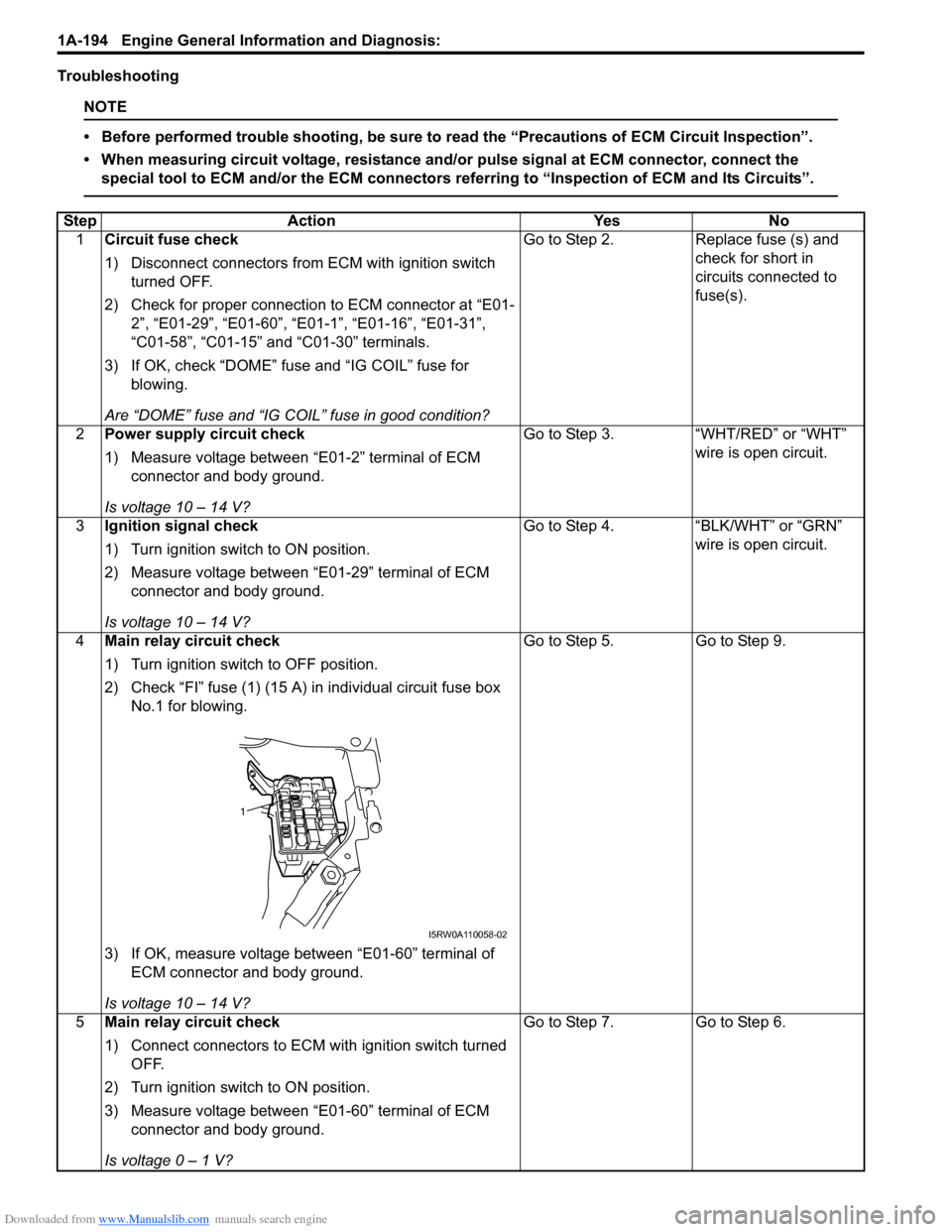
Downloaded from www.Manualslib.com manuals search engine 1A-194 Engine General Information and Diagnosis:
Troubleshooting
NOTE
• Before performed trouble shooting, be sure to read the “Precautions of ECM Circuit Inspection”.
• When measuring circuit voltage, resistance and/or pulse signal at ECM connector, connect the
special tool to ECM and/or the ECM connectors referring to “Inspection of ECM and Its Circuits”.
Step Action Yes No
1Circuit fuse check
1) Disconnect connectors from ECM with ignition switch
turned OFF.
2) Check for proper connection to ECM connector at “E01-
2”, “E01-29”, “E01-60”, “E01-1”, “E01-16”, “E01-31”,
“C01-58”, “C01-15” and “C01-30” terminals.
3) If OK, check “DOME” fuse and “IG COIL” fuse for
blowing.
Are “DOME” fuse and “IG COIL” fuse in good condition?Go to Step 2. Replace fuse (s) and
check for short in
circuits connected to
fuse(s).
2Power supply circuit check
1) Measure voltage between “E01-2” terminal of ECM
connector and body ground.
Is voltage 10 – 14 V?Go to Step 3. “WHT/RED” or “WHT”
wire is open circuit.
3Ignition signal check
1) Turn ignition switch to ON position.
2) Measure voltage between “E01-29” terminal of ECM
connector and body ground.
Is voltage 10 – 14 V?Go to Step 4. “BLK/WHT” or “GRN”
wire is open circuit.
4Main relay circuit check
1) Turn ignition switch to OFF position.
2) Check “FI” fuse (1) (15 A) in individual circuit fuse box
No.1 for blowing.
3) If OK, measure voltage between “E01-60” terminal of
ECM connector and body ground.
Is voltage 10 – 14 V?Go to Step 5. Go to Step 9.
5Main relay circuit check
1) Connect connectors to ECM with ignition switch turned
OFF.
2) Turn ignition switch to ON position.
3) Measure voltage between “E01-60” terminal of ECM
connector and body ground.
Is voltage 0 – 1 V?Go to Step 7. Go to Step 6.
1
I5RW0A110058-02